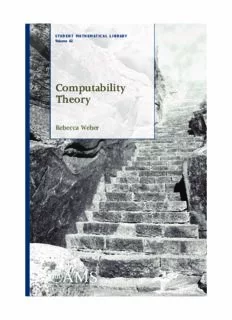Table Of ContentSTUDENT MATHEMATICAL LIBRARY
Volume 62
Computability
Theory
Rebecca Weber
Computability
Theory
STUDENT MATHEMATICAL LIBRARY
Volume 62
Computability
Theory
Rebecca Weber
American Mathematical Society
Providence, Rhode Island
Editorial Board
Gerald B. Folland Brad G. Osgood (Chair)
Robin Forman John Stillwell
2000 Mathematics Subject Classification. Primary 03Dxx;
Secondary 68Qxx.
For additional information and updates on this book, visit
www.ams.org/bookpages/stml-62
Library of Congress Cataloging-in-Publication Data
Weber,Rebecca,1977–
Computabilitytheory/RebeccaWeber.
p.cm. —(Studentmathematicallibrary;v.62)
Includesbibliographicalreferencesandindex.
ISBN978-0-8218-7392-2(alk.paper)
1.Recursiontheory. 2.Computablefunctions. I.Title.
QA9.6.W43 2012
511.3(cid:2)52—dc23
2011050912
Copying and reprinting. Individual readers of this publication, and nonprofit
libraries acting for them, are permitted to make fair use of the material, such as to
copy a chapter for use in teaching or research. Permission is granted to quote brief
passagesfromthispublicationinreviews,providedthecustomaryacknowledgmentof
thesourceisgiven.
Republication,systematiccopying,ormultiplereproductionofanymaterialinthis
publicationispermittedonlyunderlicensefromtheAmericanMathematicalSociety.
Requests for such permission should be addressed to the Acquisitions Department,
AmericanMathematicalSociety,201CharlesStreet,Providence,RhodeIsland02904-
2294USA.Requestscanalsobemadebye-mailtoreprint-permission@ams.org.
(cid:2)c 2012bytheAmericanMathematicalSociety. Allrightsreserved.
TheAmericanMathematicalSocietyretainsallrights
exceptthosegrantedtotheUnitedStatesGovernment.
PrintedintheUnitedStatesofAmerica.
(cid:2)∞ Thepaperusedinthisbookisacid-freeandfallswithintheguidelines
establishedtoensurepermanenceanddurability.
VisittheAMShomepageathttp://www.ams.org/
10987654321 171615141312
Contents
Chapter 1. Introduction 1
§1.1. Approach 1
§1.2. Some History 4
§1.3. Notes on Use of the Text 6
§1.4. Acknowledgements and References 7
Chapter 2. Background 9
§2.1. First-Order Logic 9
§2.2. Sets 15
§2.3. Relations 21
§2.4. Bijection and Isomorphism 29
§2.5. Recursion and Induction 30
§2.6. Some Notes on Proofs and Abstraction 37
Chapter 3. Defining Computability 41
§3.1. Functions, Sets, and Sequences 41
§3.2. Turing Machines 43
§3.3. Partial Recursive Functions 50
§3.4. Coding and Countability 56
§3.5. A Universal Turing Machine 62
v
vi Contents
§3.6. The Church-Turing Thesis 65
§3.7. Other Definitions of Computability 66
Chapter 4. Working with Computable Functions 77
§4.1. The Halting Problem 77
§4.2. The “Three Contradictions” 78
§4.3. Parametrization 79
§4.4. The Recursion Theorem 81
§4.5. Unsolvability 85
Chapter 5. Computing and Enumerating Sets 95
§5.1. Dovetailing 95
§5.2. Computing and Enumerating 96
§5.3. Aside: Enumeration and Incompleteness 102
§5.4. Enumerating Noncomputable Sets 105
Chapter 6. Turing Reduction and Post’s Problem 109
§6.1. Reducibility of Sets 109
§6.2. Finite Injury Priority Arguments 115
§6.3. Notes on Approximation 124
Chapter 7. Two Hierarchies of Sets 127
§7.1. Turing Degrees and Relativization 127
§7.2. The Arithmetical Hierarchy 131
§7.3. Index Sets and Arithmetical Completeness 135
Chapter 8. Further Tools and Results 139
§8.1. The Limit Lemma 139
§8.2. The Arslanov Completeness Criterion 142
§8.3. E Modulo Finite Difference 145
Chapter 9. Areas of Research 149
§9.1. Computably Enumerable Sets and Degrees 149
§9.2. Randomness 155
§9.3. Some Model Theory 169
Contents vii
§9.4. Computable Model Theory 174
§9.5. Reverse Mathematics 177
Appendix A. Mathematical Asides 189
§A.1. The Greek Alphabet 189
§A.2. Summations 190
§A.3. Cantor’s Cardinality Proofs 190
Bibliography 193
Index 199
Chapter 1
Introduction
The bird’s-eye view of computability: what does it mean, how does
it work, where did it come from?
1.1. Approach
If I can program my computer to execute a function, to take any
input and give me the correct output, then that function should cer-
tainly be called computable. That set of functions is not very large,
though; I am not a particularly skilled programmer and my com-
puterisnothingspectacular. Imightexpandmydefinitiontosayifa
wizardlyprogrammer canprogramthebestcomputerthereistoexe-
cute afunction, thatfunction is computable. However, programming
languages and environments improve with time, making it easier to
programcomplicatedfunctions,andcomputersincreaseinprocessing
speed and amount of working memory.
The idea of “computable” as “programmable” provides excellent
intuition, but the precise mathematical definition needs to be an ide-
alizedversionthatdoesnotchangewithhardwareadvances. Itshould
capture all of the functions that may be automated even in theory.
To that end, computability theory removes any restriction on
timeandmemoryexceptthatasuccessfulcomputationmustuseonly
finitely much of each. When that change is made, the rest of the
1
Description:What can we compute--even with unlimited resources? Is everything within reach? Or are computations necessarily drastically limited, not just in practice, but theoretically? These questions are at the heart of computability theory. The goal of this book is to give the reader a firm grounding in the

